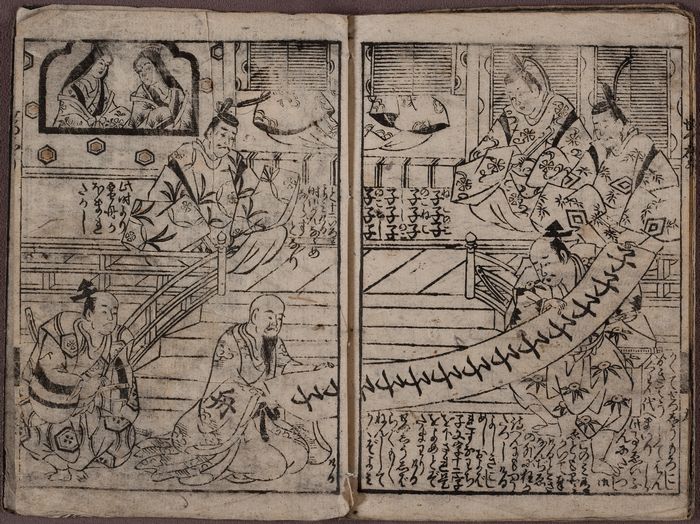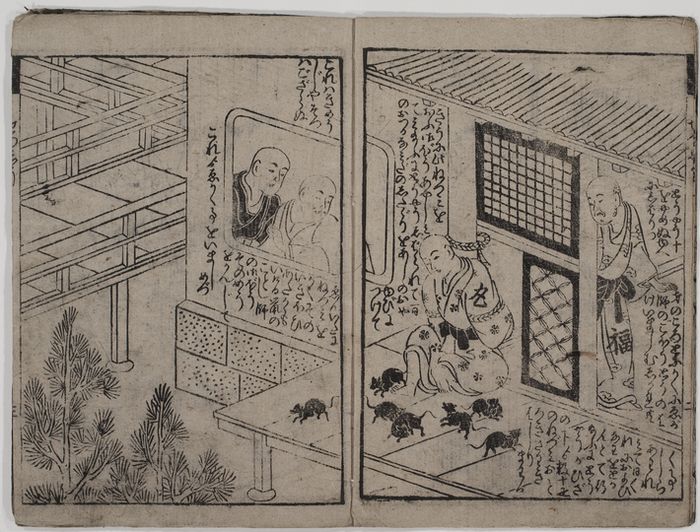Child child child child child child child child child child child child child
« previous post | next post »
Following on the hoofs of "Sumomomomomomomomo" (11/17/21), here's another good one, from rit majors:

(source)
For context:
Both panels are from the same published book in the University of Tokyo library (drawing by Torii Kiyomasu or Torii Kiyomitsu, Horeki 8 [1758] [accession number E24: 1310], formerly in the collection of Koichi Toyama; 刊本 鳥居清倍または鳥居清満作画 宝暦8 年[1758] 【書庫E24:1310】).
On the scroll is a succession of thirteen 子子子子子子子子子子子子子.
To show the enormous phonological complexity and lexical usage of kanji, here follows an extensive, but far from exhaustive, treatment of 子 in Japanese (per Wiktionary [abbreviated]).
Definition of 子:
- child
- honorific for an adult man
- honorific for a learned man, master
- man in general
- fourth rank of nobility in Meiji–postwar Japan, viscount
- egg, fruit, seed
- small object
- interest
- diminutive suffix
- Rat (earthly branch)
Readings
- Go-on: し (shi, Jōyō)
- Kan-on: し (shi, Jōyō)
- Tō-on: す (su, Jōyō)
- Sō-on: つ (tsu)
- Kan’yō-on: ず (zu)
- Kun: こ (ko, 子, Jōyō); ね (ne, 子); み (mi, 子)
- Nanori: このえ (konoe); さね (sane); しげ (shige); しげる (shigeru); たか (taka); ただ (tada); たね (tane); ちか (chika); つぐ (tsugu); とし (toshi); みる (miru); やす (yasu)
Etymology 1
From Old Japanese, attested in the Kojiki (712 C.E.) and the Man'yōshū (c. 759 C.E.), two of the oldest examples of written Japanese.⟨ko1⟩ → */kʷo/ → /ko/
Cognate with 蚕 (ko, “silkworm”) and possibly 小 (ko, “little”, diminutive prefix).
Noun
- a child
- (figuratively) a girl, especially a dear or desired one (compare use of English baby, babe)
- a smaller or younger version of a bigger object
- (hanafuda, card games, by extension, board games, gambling) person who is dealt cards
Prefix
- an object which has a subservient or derivative role relative to another object
- suffix used in female given names, such as 智子 (Tomoko), 英子 (Eiko), 秀子 (Hideko), 美奈子 (Minako)
- (rare) suffix used in male given names
- an object having a particular state or property (sometimes diminutive)
- roe (only when preceded by a fish name, or fish-related prefix)
- 明太子 (mentaiko, “pollock roe”)
- 飛子 (tobiko, “flying fish roe”)
Etymology 2
The goon reading of shi is likely the original borrowing:From Middle Chinese 子 (MC t͡sɨX), also used in the Man'yōshū (c. 759 C.E.) as 借音 (shakuon) kana for ⟨si⟩. Compare modern Mandarin 子 (zǐ).
- /t͡sɨ/ → /sɨ/ → */ɕɨ/ → /ɕi/
The tōon reading su appears later, and only shows up in certain set terms borrowed from Chinese, where it seems to serve as a kind of nominalizing suffix:
- /t͡sɨ/ → /sɨ/ → */sʉ/ → /su/
Pronunciation
Affix
- a child
- Short for 子爵 (shishaku): the fourth rank of nobility in Meiji–postwar Japan, equivalent to a viscount
- an honorific for a learned man, such as teacher or master
- a philosophy branch of Chinese literature, either derived from or outside of the Hundred Schools of Thought
- an object which has a subservient or derivative role relative to another object
- an object having a particular state or property (sometimes diminutive)
Usage notes
- This affix is never used in isolation. It is only used in on'yomi compounds.
- In some kanji compounds, 子 is part of the word but does not carry much meaning in Japanese, as in 椅子 (isu, “chair”). Possibly because of this erosion of meaning, spelling out 子 in some compounds has become optional, as in 椰子 vs. 椰 (yashi, “a palm tree”), or 柚子 vs. 柚 (yuzu, “an aromatic citron”).
- In some compounds, the shi or su reading becomes voiced as ji or zu due to rendaku.
Pronoun
- (archaic) second-person pronoun: you (of one's equals)
Proper noun
- (Chinese astrology) Rat, the first of the twelve Earthly Branches
Etymology 3
Contracted from 鼠 (nezumi, “mouse, rat”)
Pronunciation
Proper noun
- (Chinese astrology) Rat, the first of the twelve Earthly Branches:
- a place name
Syllable
子 • (ne)
Etymology 4
子(み) • (mi) Noun
(archaic, rare) Alternative spelling of 実 (mi): a fruit, nut, or seed (of a plant, tree, etc.); ingredients put in a soup; a content, substance
I honestly don't know how to pronounce this string of thirteen 子 kanji, but Google Translate reads it as "sunegoshinejiko-ko-ko sunekoshi" and translates it into English as "child child child child child child child child child child child child child child child child child child child child child child child child child child child child child child child child child child child child child child child child child child child child child child child child child".
Bing Translator romanizes the string as "ko ko ko ko ko ko ko ko ko ko ko ko ko" and renders it into English as "hild child child child child child child child".
Baidu Fanyi doesn't romanize the string, but listening to the speech generator, it seems to give "zi zi zi zi zi zi zi zi zi zi zi zi zi" for the pronunciation and "child and child child child child child" for the translation.
All that aside, I surmise that the patriarch in the illustration is contemplating a long succession of male heirs, not a bunch of girls. Alas!
Selected readings
- "An evening with Victor Mair", Pluck Tea (6/1/11)
- "Recognizing half of a character and half of a word" (5/2/21)

Anonymous said,
November 20, 2021 @ 10:50 am
https://en.wikipedia.org/wiki/Ono_no_Takamura#Ujish%C5%ABi_Monogatari
~flow said,
November 21, 2021 @ 5:30 am
I only count twelve 子 on the scroll, one of them going across two pages?
There is an annotated version of the same depicted on the wall above the scroll, it's somewhat hard to read but seems to say
'ねこのこ のこねこ ししのこ のこひし'
This is almost identical to the text given in the Wikipedia article anonymous linked:
'ねこのこ こねこ ししのこ こじし'
with the addition of two の and one ひ(?) that should be じ (in a modern reading at least).
I suspect the additional の might be thematic particles, so 'ねこのこの、こねこ' "as for the offspring of cats, those are kittens" (a more modern version would be 'ねこのこって、こねこですね' or similar). Those の are epenthetic / inserted at appropriate points without being written in 子子子子子子子子子子子子, so one can imagine there being even more, according to interpretation.
David Marjanović said,
November 21, 2021 @ 7:44 am
So I wondered if "neutrino" is 中性子子, but no: the closest is 中性微子, and the Wikipedia article is under ニュートリノ.
Victor Mair said,
November 23, 2021 @ 4:15 pm
From Julia Lammers:
In Japanese Classical Literature, there is an episode of the line in the story of Uji-shu-mono-gatari:
During the Heian Period, there was a sign at the Imperial Palace that read "無悪善." Emperor Saga asked a scholar if he could read and interpret what it says and the scholar told the Emperor that it means "悪無くて善からん” or "Wishing that the Emperor didn't exist (without a subject, so you can't tell who wrote it) and with great frustration, the Emperor accused the scholar of being the one who wrote the sign since he was able to read it. The scholar answered: "I can read anything." So the Emperor asked him to read "子子子子子子子子子子子子" which the scholar read as "Nekonokokoneko, shishinokokojishi" and they laughed together.
It's unknown whether the story above is true, but it demonstrates the great wit that scholar Ono no Takamura was known to have.
https://www.huffingtonpost.jp/entry/takamura_jp_5dcbcd1ce4b03a7e02924115